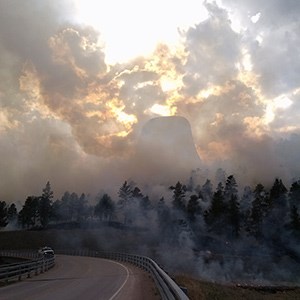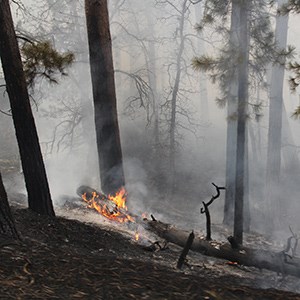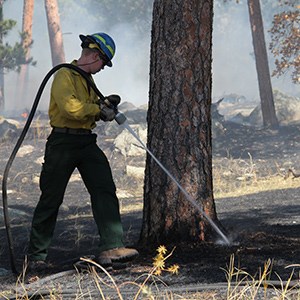When you think of wildfires, what comes to mind?Most people think that fires are destructive, random, and dangerous, but these things are only partially true. Fire is a natural process that shapes ecosystems and landscapes, allowing for the regeneration and rebirth of ancient forests. Wildfires are random to some extent, but also occur in a cycle that takes place over many years. And, if managed carefully, regular fires can actually help to keep people safe.
NPS photo Wildland Fire EcologyWhat role does wildfire play in the ecosystem?Fire is often feared for the destruction it causes, but in nature this destruction is what makes it so important. As a tree grows, it sheds a lot of dead material. Pine needles, dead branches, and even dead trees pile up on the forest floor, keeping valuable nutrients locked away from living plants. Regular fires clear out low-growing bushes and small trees, thin any overabundant pine seedlings, and return essential nutrients that are trapped in dead plants to the soil.When there is only a little bit of fuel fires are rare, but as fuel builds up wildfires become practically inevitable. Different ecosystems take more or less time to reach this critical point, but most ecosystems have a very regular fire cycle that happens naturally. Here at Devils Tower, there will be a fire every 10-15 years without human intervention. The majority of the park is covered in a ponderosa pine forest that is dominated by spaced trees and low-growing grasses. The healthy, open forest is maintained primarily by fire and has adapted to its presence. Fire is an integral part of the forest ecosystem. Who do wildfires help?The entire forest depends on regular wildfires, and there are some species that cannot live without it. Ponderosa pine, the most common tree species in the park, is especially well adapted to fires. Its thick bark protects its core, and its sap is a fire suppressant. As the tree grows it drops its lowest branches to prevent fires from “crowning,” or reaching the top of the tree. Many species in the park depend on the ponderosa pine for habitat and food, like the porcupine that eats its bark and sleeps in its branches, or the insects and birds that make their homes in the trees. One uncommon bird, the black-backed woodpecker, will travel from place to place searching for recent fires to find its favorite food: wood-boring beetles. Even the northern long-eared bat, a threatened species, benefits from frequent wildfires. The bats will roost under the bark of burned trees and in snags that were killed by the fire. These species, and many others, depend on a healthy and regular fire cycle.
NPS photo What would happen if there were no wildfires?As time passed, dead material would continue to pile up. More seedlings would grow to adulthood, creating more shade and changing the plant life on the ground. Over time, ponderosa pines would be out-competed by other trees and the canopy composition of the forest would change. The classic ponderosa pine forests that are here today would disappear.Without wildfires, some populations that fire keeps in check would grow rapidly. The pine bark beetle, a native species that normally has a low population density, would become more common and cause more damage to pine trees than it does in areas with regular fires. Pine bark beetles can decimate forests if left unchecked. In many places where fires have been suppressed, these predictions have started to come true. But fires cannot be suppressed forever, and when wildfires finally do start they have more fuel and become much larger than normal wildfires. Maintaining the natural fire cycle helps keep forests healthy and protects people from out-of-control wildfires. 
Wildland Fire ManagementWhen the National Park Service was founded in 1916, it was standard practice and policy to suppress all fires that started on federal land. It was not until the 1970s that parks started experimenting with re-introducing fire into ecosystems. Devils Tower National Monument enacted its first Fire Management Plan in 1991 and introduced prescribed fire to the park. Prescribed fires are planned, controlled fires set by fire professionals to mimic the effects of natural wildfires. They have many of the benefits of natural wildfire, but much less risk. Prescribed fires are only set if temperature, moisture, and wind conditions are within a specific range so that firefighting teams will always have the fire under control.Today, Devils Tower conducts prescribed fires in the spring and fall. These fires mimic the natural fire cycle and happen in each area of the park about every fifteen years. Different sections of the park are burned in different years, so as you walk around the park you might see different stages of the fire cycle. These fires keep the forests healthy, keep the people safe, and help provide habitat to many species. 
NPS photo To learn more about fire in the national parks, visit the park service website on fire or the National Interagency Fire Center site. 
Created by Annelise Rue-Johns |
Last updated: April 24, 2025
